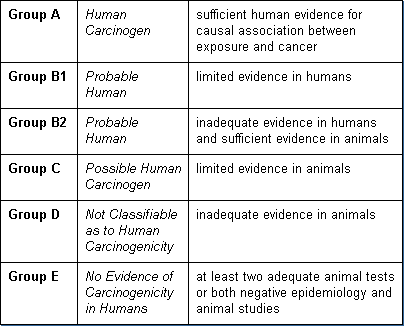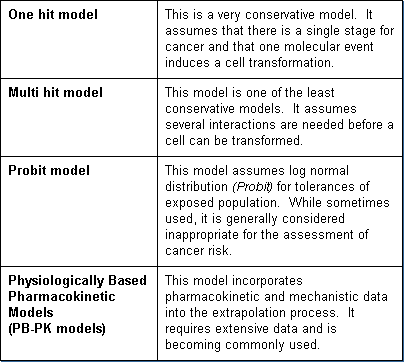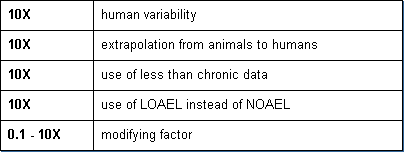|
 |
 |
 |
 |
|
|
|






Dose-Response Assessment

The dose-response assessment step quantitates the hazards which were identified in the hazard evaluation phase. It determines the relationship between dose and incidence of effects in humans. There are normally two major extrapolations required. The first is from high experimental doses to low environmental doses and the second from animal to human doses.
The procedures used to extrapolate from high to low doses are different for assessment of carcinogenic effects and non-carcinogenic effects. Carcinogenic effects are not considered to have a threshold and mathematical models are generally used to provide estimates of carcinogenic risk at very low dose levels.
Noncarcinogenic effects (e.g. neurotoxicity) are considered to have dose thresholds below which the effect does not occur. The lowest dose with an effect in animal or human studies is divided by Safety Factors to provide a margin of safety.
Cancer Risk Assessment

Cancer risk assessment involves two steps. The first step is a qualitative evaluation of all
epidemiology studies, animal bioassay data, and biological activity (e.g., mutagenicity). The substance is classified as to carcinogenic risk to humans based on the weight of evidence. If the evidence is sufficient, the substance may be classified as a definite, probable or possible human carcinogen.
The second step is to quantitate the risk for those substances classified as definite or probable human carcinogens. Mathematical models are used to extrapolate from the high experimental doses to the lower environmental doses.
The two primary cancer classification schemes are those of the Environmental Protection Agency (EPA) and the International Agency for Research on Cancer (IARC). The EPA and IARC classification systems are quite similar.
The EPA's cancer assessment procedures have been used by several Federal and State agencies. The Agency for Toxic Substances and Disease Registry (ATSDR) relies on EPA's carcinogen assessments. A substance is assigned to one of six categories as shown below:

The basis for sufficient human evidence is an
epidemiology study that clearly demonstrates a causal relationship between exposure to the substance and cancer in humans. The data are determined to be limited evidence in humans if there are alternative explanations for the observed effect. The data are considered to be inadequate evidence in humans if no satisfactory
epidemiology studies exist.
An increase in cancer in more than one species or strain of laboratory animals or in more than one experiment is considered sufficient evidence in animals. Data from a single experiment can also be considered sufficient animal evidence if there is a high incidence or unusual type of tumor induced. Normally, however, a carcinogenic response in only one species, strain, or study, is considered as only limited evidence in animals.
When an agent is classified as a Human or Probable Human Carcinogen, it is then subjected to a quantitative risk assessment. For those designated as a Possible Human Carcinogen, the risk assessor can determine on a case-by-case basis whether a quantitative risk assessment is warranted.
The key risk assessment parameter derived from the EPA carcinogen risk assessment is the cancer slope factor. This is a toxicity value that quantitatively defines the relationship between dose and response. The cancer slope factor is a plausible upper-bound estimate of the probability that an individual will develop cancer if exposed to a chemical for a lifetime of 70 years. The cancer slope factor is expressed as mg/kg/day.
Mathematical models are used to extrapolate from animal bioassay or
epidemiology data to predict low dose risk. Most assume linearity with a zero threshold dose.
EPA uses the Linearized Multistage Model (LMS) illustrated above to conduct its cancer risk assessments. It yields a cancer slope factor, known as the q1* (pronounced Q1-star) which can be used to predict cancer risk at a specific dose. It assumes linear extrapolation with a zero dose threshold from the upper confidence level of the lowest dose that produced cancer in an animal test or in a human
epidemiology study.
Other models that have been used for cancer assessments include:

Estimated drinking water concentrations for chlordane that will cause a lifetime risk of one cancer death in a million persons, derived from different cancer risk assessment models, vary as illustrated below:

PB-PK models are relatively new and are being employed when biological data are available. They quantitate the absorption of a foreign substance, its distribution, metabolism, tissue compartments, and elimination. Some compartments store the chemical (bone and adipose tissue) whereas others biotransform or eliminate it (liver or kidney). All these biological parameters are used to derive the target dose and comparable human doses.
Non-carcinogenic Risk Assessment

Historically, the Acceptable Daily Intake (ADI) procedure has been used to calculate permissible chronic exposure levels for humans based on non-carcinogenic effects. The ADI is the amount of a chemical to which a person can be exposed each day for a long time (usually lifetime) without suffering harmful effects. It is determined by applying safety factors (to account for the uncertainty in the data) to the highest dose in human or animal studies which has been demonstrated not to cause toxicity (NOAEL).
The EPA has slightly modified the ADI approach and calculates a Reference Dose (RfD) as the acceptable safety level for chronic non-carcinogenic and developmental effects. Similarly the ATSDR calculates Minimal Risk Levels (MRLs) for noncancer end points.
The critical toxic effect used in the calculation of an ADI, RfD, or MRL is the serious adverse effect which occurs at the lowest exposure level. It may range from lethality to minor toxic effects. It is assumed that humans are as sensitive as the animal species unless evidence indicates otherwise.
In determining the ADIs, RfDs or MRLs, the NOAEL is divided by safety factors (uncertainty factors) in order to provide a margin of safety for allowable human exposure.

When a NOAEL is not available, a LOAEL can be used to calculate the RfD. An additional safety factor is included if an LOAEL is used. A Modifying Factor of 0.1-10 allows risk assessors to use scientific judgment in upgrading or downgrading the total uncertainty factor based on the reliability and quality of the data. For example, if a particularly good study is the basis for the risk assessment, a modifying factor of < 1 may be used. If a poor study is used, a factor of >1 can be incorporated to compensate for the uncertainty associated with the quality of the study.
A dose response curve for non-carcinogenic effects is illustrated above which also identifies the NOAEL and LOAEL. Any toxic effect might be used for the NOAEL/LOAEL so long as it is the most sensitive toxic effect and considered likely to occur in humans.
The Uncertainty Factors or Safety Factors used to derive an ADI or RfD are:

The modifying factor is used only in deriving EPA Reference Doses. The number of factors included in calculating the ADI or RfD depend upon the study used to provide the appropriate NOAEL or LOAEL.
The general formula for deriving the RfD is:

The more uncertain or unreliable the data becomes, the higher will be the total uncertainty factor that is applied. An example of an RfD calculation is provided below. A subchronic animal study with a LOAEL of 50 mg/kg/day was used. Thus the uncertainty factors are: 10 for human variability, 10 for an animal study, 10 for less than chronic exposure, and 10 for use of an LOAEL instead of a NOAEL.

In addition to chronic effects, RfDs can also be derived for other long term toxic effects, including developmental toxicity.
While ATSDR does not conduct cancer risk assessments, it does derive Minimal Risk Levels (MRLs) for noncancer toxicity effects (such as birth defects or liver damage). The MRL is defined as an estimate of daily human exposure to a substance that is likely to be without an appreciable risk of adverse effects over a specified duration of exposure. For inhalation or oral routes, MRLs are derived for acute (14 days or less), intermediate (15-364 days), and chronic (365 days or more) durations of exposures.
The method used to derive MRLs is a modification of the EPA's RfD methodology. The primary modification is that the uncertainty factors of 10 may be lower, either 1 or 3, based on scientific judgment. These uncertainty factors are applied for human variability, interspecies variability (extrapolation from animals to humans), and use of a LOAEL instead of NOAEL. As in the case of RfDs, the product of uncertainty factors multiplied together is divided into the NOAEL or LOAEL to derive the MRL.
Risk assessments are also conducted to derive permissible exposure levels for acute or short term exposures to chemicals. Health Advisories (HAs) are determined for chemicals in drinking water. HAs are the allowable human exposures for one day, ten days, longer-term, and lifetime durations. The method used to calculate HAs is similar to that for the RfD's using uncertainty factors. Data from toxicity studies with durations of length appropriate to the HA are being developed.
For occupational exposures, Permissible Exposure Levels (PELs), Threshold Limit Values (TLVs), and NIOSH Recommended Exposure Levels (RELs) are developed. They represent dose levels that will not produce adverse health effects from repeated daily exposures in the workplace. The method used to derive is conceptually the same. Safety factors are used to derive the PELs, TLVs, and RELs.
Animal doses must be converted to human dose equivalents. The human dose equivalent is based on the assumption that different species are equally sensitive to the effects of a substance per unit of body weight or body surface area.
Historically, FDA used a ratio of body weights of humans to animals to calculate the human dose equivalent. EPA has used a ratio of surface areas of humans to animals to calculate the human dose equivalent. The animal dose was multiplied by the ratio of human to animal body weight raised to the 2/3rd power (to convert from body weight to surface area). FDA and EPA have agreed to use body weight raised to the 3/4th power to calculate human dose equivalents in the future.
The last step in risk assessment is to express the risk in terms of allowable exposure to a contaminated source. Risk is expressed in terms of the concentration of the substance in the environment where human contact occurs. For example, the unit risk in air is risk per mg/m3 whereas the unit risk in drinking water is risk per mg/L.
For carcinogens, the media risk estimates are calculated by dividing cancer slope factors by 70 kg (average weight of man) and multiplying by 20 m3/day (average inhalation rate of an adult) or 2 liters/day (average water consumption rate of an adult).

  
|
|
|
|